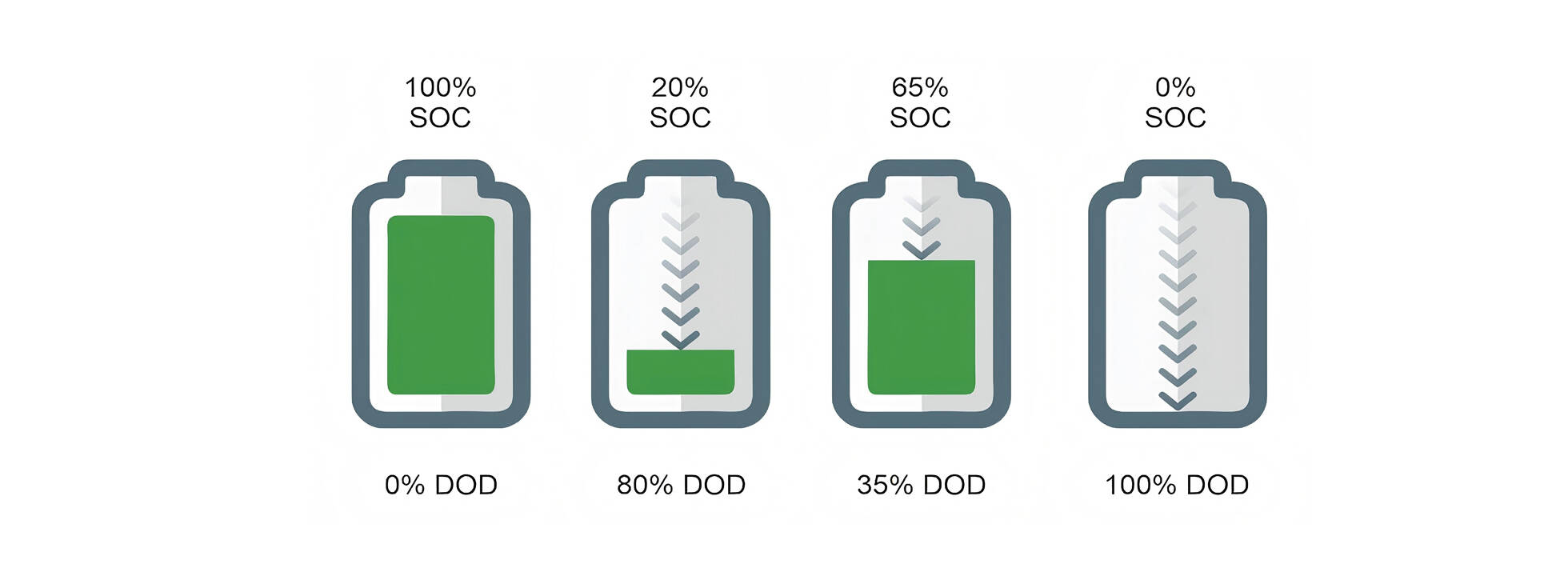Language
Currency


As lithium-ion energy storage systems become increasingly essential in residential solar setups, commercial and industrial energy storage, and electric vehicles, one factor plays a pivotal role in system efficiency and battery longevity: Depth of Discharge (DOD).
This article explains what DOD means, how it affects battery life and system performance, and how to optimize DOD settings for different applications.
Depth of Discharge (DOD) refers to the percentage of a battery’s capacity that has been used during a discharge cycle. Simply put, it measures how much of the battery’s stored energy has been consumed.
For example, if a 10kWh battery discharges 5kWh, the DOD for that cycle is 50%. The deeper the discharge (i.e., the higher the DOD), the more stress is placed on the battery — which directly affects its longevity.
Battery lifespan is often measured in charge-discharge cycles. There is a clear inverse relationship between DOD and the number of cycles a battery can endure:
A higher DOD releases more energy per cycle but reduces the total number of cycles.
A lower DOD preserves battery health and extends its usable life.
For instance, a lithium battery operating at 80% DOD may offer around 3,000 cycles, whereas the same battery at 50% DOD could exceed 6,000 cycles. Properly managing DOD can delay capacity degradation while maintaining acceptable energy utilization.
In energy storage systems, DOD affects both economic return and system efficiency.
A high DOD increases energy output per cycle but accelerates battery wear and replacement costs.
A low DOD enhances longevity but reduces the energy available per cycle.
Therefore, choosing the optimal DOD setting is crucial. Balancing DOD based on the specific application, usage patterns, and budget can lead to longer battery lifespan, reduced maintenance, and more stable system performance.
While DOD is critical, several additional variables impact battery health:
Charge/Discharge Rate (C-rate): High C-rates accelerate internal wear and degrade performance.
Operating Temperature: Extreme heat or cold can significantly shorten battery lifespan. Effective thermal management is essential.
Battery Management System (BMS): A smart BMS continuously monitors and optimizes battery operation, including DOD control.
Charging Strategy: Gentle and controlled charging protocols reduce stress and extend service life.
Battery usage scenarios vary, and so should DOD strategies:
Residential Energy Storage: A moderate DOD (around 60–80%) typically balances daily energy use and longevity.
Commercial & Industrial Systems: DOD should be optimized for ROI and load patterns, allowing for more dynamic energy management.
Backup Power Systems: A lower DOD is often preferred to ensure long-term standby reliability.
Smart energy management systems can help dynamically adjust DOD based on load demand, environmental factors, and battery characteristics.
DOD is a critical metric in energy storage. A scientific approach to understanding and managing DOD can significantly enhance a system’s operational efficiency and economic performance.
By optimizing DOD, energy storage users can:
Extend battery lifespan
Reduce replacement frequency
Improve overall energy utilization
Maximize long-term return on investment
Take the Yohoo Elec High-Voltage Series as an example. Featuring Grade-A lithium cells and a high-performance smart BMS, these batteries maintain an exceptional cycle life of up to 8,000 cycles even at 80% DOD under standard conditions.
This durability makes Yohoo Elec batteries ideal for both residential and commercial scenarios requiring frequent charging and discharging — offering a balanced solution between power availability and long-term reliability.
Kesalahan format email
emailCannotEmpty
emailDoesExist
pwdLetterLimtTip
inconsistentPwd
pwdLetterLimtTip
inconsistentPwd